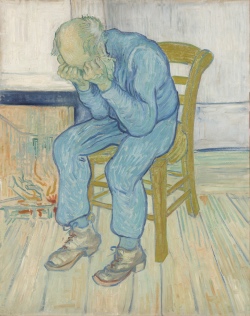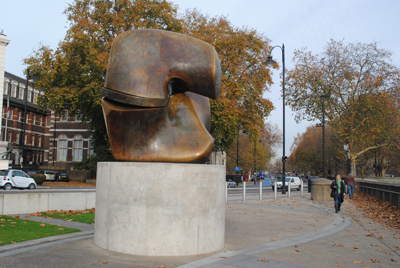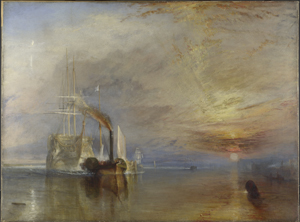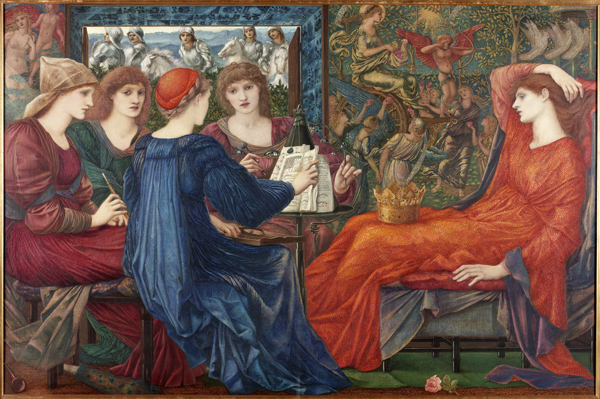 • The first exhibition to examine the work of Dutch artist Vincent van Gogh through his relationship with Britain has opened at Tate Britain this week. Van Gogh and Britain includes more than 40 works by the artist including L’Arlésienne (1890), Starry Night on the Rhone (1888), and Sunflowers (1888). The exhibition will also feature later works by Van Gogh including two he painted while in the Saint-Paul asylum – At Eternity’s Gate (1890 – pictured) and Prisoners Exercising (1890). The exhibition shows how Van Gogh, who lived in London between 1873 and 1876 working as a trainee art dealer, responded to works by artists like John Constable and John Everett Millais and his love of British writers like William Shakespeare, Christina Rossetti and, particularly, Charles Dickens (L’Arlésienne features one of Dickens’ favourite books in the foreground). The show runs until 11th August and is being accompanied by a series of talks and other events. Admission charge applies. For more, see www.tate.org.uk. PICTURE: Vincent van Gogh (1853 –1890), ‘Sorrowing old man (‘At Eternity’s Gate’)’ (1890), Collection Kröller-Müller Museum, Otterlo
• The first exhibition to examine the work of Dutch artist Vincent van Gogh through his relationship with Britain has opened at Tate Britain this week. Van Gogh and Britain includes more than 40 works by the artist including L’Arlésienne (1890), Starry Night on the Rhone (1888), and Sunflowers (1888). The exhibition will also feature later works by Van Gogh including two he painted while in the Saint-Paul asylum – At Eternity’s Gate (1890 – pictured) and Prisoners Exercising (1890). The exhibition shows how Van Gogh, who lived in London between 1873 and 1876 working as a trainee art dealer, responded to works by artists like John Constable and John Everett Millais and his love of British writers like William Shakespeare, Christina Rossetti and, particularly, Charles Dickens (L’Arlésienne features one of Dickens’ favourite books in the foreground). The show runs until 11th August and is being accompanied by a series of talks and other events. Admission charge applies. For more, see www.tate.org.uk. PICTURE: Vincent van Gogh (1853 –1890), ‘Sorrowing old man (‘At Eternity’s Gate’)’ (1890), Collection Kröller-Müller Museum, Otterlo
• On Now – Elizabethan Treasures: Miniatures by Hilliard and Oliver. This exhibition at the National Portrait Gallery – which is focused on the work of Nicholas Hilliard (1547-1619) and Isaac Oliver (c1565-1617) – is the first major display of Tudor and Jacobean portrait miniatures to be held in the UK for more than 35 years and includes new discoveries as well as portraits on public display for the first time. A large section of the exhibition is devoted to portraits of Queen Elizabeth I as well as King James I, his wife Anne of Denmark and his three children – Henry, Elizabeth and Charles (later King Charles II). There are also miniatures of famous figures like Sir Walter Ralegh, Sir Francis Drake and a little known portrait of Shakespeare’s patron, the Earl of Southampton. Other highlights include a previously unknown portrait by Hilliard of King Henri III of France. Runs until 19th May. Admission charge applies. For more, see www.npg.org.uk.
• A major exhibition exploring the role of money in Jewish life has opened at the Jewish Museum London in Camden Town. Jews, Money, Myth looks at the “ideas, myths and stereotypes” that link money and Jews over two millennia. It features art works such as Rembrandt’s Judas Returning the Thirty Pieces of Silver as well as new commissions by Jeremy Deller and Doug Fishbone along with film, literature and cultural emphemera ranging from board games and cartoons to costumes and figurines. There are a series of related events. For more, see www.jewishmuseum.org.uk.
Send all items for inclusion to exploringlondon@gmail.com.








